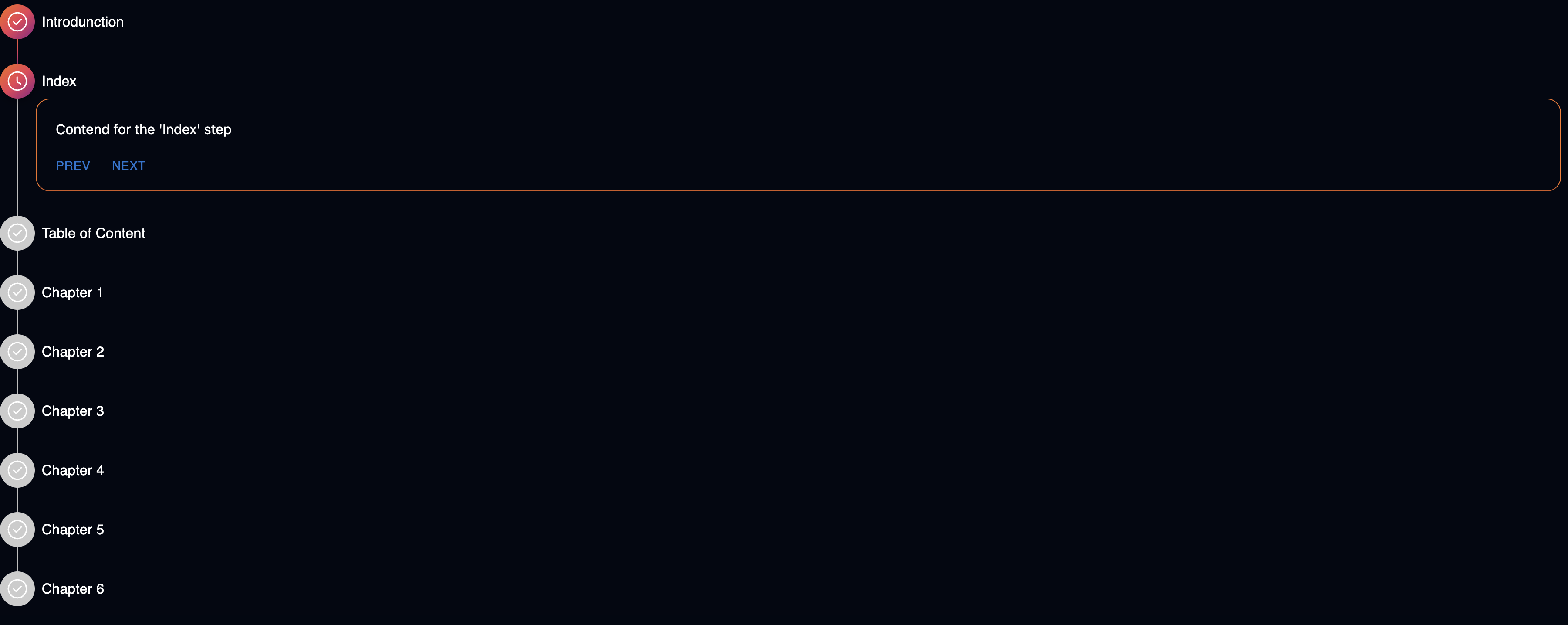Create Beautiful Vertical Stepper in React Using MUI + TailwindCSS
· 3 min read
In this post, we’ll walk through how to create a visually appealing vertical stepper component in React using Material UI (MUI) and Tailwind CSS. This component is fully customizable and comes with gradient connectors, icons, and styled content boxes.

🎯 Goal
We'll build a VerticleStepper component that:
- Uses MUI’s
Stepper,Step, andStepLabel. - Has a custom connector and step icon.
- Works with Tailwind for enhanced styling.
- Is reusable and accepts steps and active state as props.
🧱 Step 1: Build the Component
Create a VerticleStepper.tsx file and paste the following code:
import React from "react";
import Stepper from "@mui/material/Stepper";
import Step from "@mui/material/Step";
import StepLabel from "@mui/material/StepLabel";
import {
StepConnector,
stepConnectorClasses,
StepContent,
styled,
Typography,
type StepIconProps,
} from "@mui/material";
import { Clock, TickCircle } from "iconsax-reactjs";
export interface VerticleStepperStep {
label: string;
content: React.JSX.Element;
}
export interface VerticleStepperProps {
steps: VerticleStepperStep[];
activeStep: number;
}
// Custom connector with gradient style
const ColorlibConnector = styled(StepConnector)(({ theme }) => ({
[`&.${stepConnectorClasses.alternativeLabel}`]: {
top: 22,
},
[`&.${stepConnectorClasses.active}, &.${stepConnectorClasses.completed}`]: {
[`& .${stepConnectorClasses.line}`]: {
backgroundImage:
"linear-gradient( 95deg, rgb(242,113,33) 0%, rgb(233,64,87) 50%, rgb(138,35,135) 100%)",
},
},
[`& .${stepConnectorClasses.line}`]: {
height: 36,
border: 0,
width: 1,
marginLeft: 8,
marginTop: -8,
marginBottom: -8,
backgroundColor: "#bdbdbd",
...theme.applyStyles("dark", {
backgroundColor: theme.palette.grey[800],
}),
},
}));
// Custom step icon
const ColorlibStepIconRoot = styled("div")<{
ownerState: { completed?: boolean; active?: boolean };
}>(({ theme }) => ({
backgroundColor: "#ccc",
zIndex: 1,
color: "#fff",
width: 40,
height: 40,
display: "flex",
borderRadius: "50%",
justifyContent: "center",
alignItems: "center",
...theme.applyStyles("dark", {
backgroundColor: theme.palette.grey[700],
}),
variants: [
{
props: ({ ownerState }) => ownerState.active,
style: {
backgroundImage:
"linear-gradient( 136deg, rgb(242,113,33) 0%, rgb(233,64,87) 50%, rgb(138,35,135) 100%)",
boxShadow: "0 4px 10px 0 rgba(0,0,0,.25)",
},
},
{
props: ({ ownerState }) => ownerState.completed,
style: {
backgroundImage:
"linear-gradient( 136deg, rgb(242,113,33) 0%, rgb(233,64,87) 50%, rgb(138,35,135) 100%)",
},
},
],
}));
function ColorlibStepIcon(props: StepIconProps) {
const { active, completed, className } = props;
return (
<ColorlibStepIconRoot
ownerState={{ completed, active }}
className={className}
>
{active ? <Clock size={25} /> : <TickCircle size={25} />}
</ColorlibStepIconRoot>
);
}
// Final component
export const VerticleStepper = ({
steps,
activeStep,
}: VerticleStepperProps) => {
return (
<Stepper
activeStep={activeStep}
orientation="vertical"
connector={<ColorlibConnector />}
>
{steps.map(({ label, content }) => (
<Step key={label}>
<StepLabel StepIconComponent={ColorlibStepIcon}>
<Typography className="text-white">{label}</Typography>
</StepLabel>
<StepContent style={{ marginLeft: 20, marginTop: "-8px" }}>
<div className="border-1 rounded-2xl p-2.5 border-[rgb(242,113,33)] border-r-[rgb(260,119,33)] border-b-[rgb(210,90,33)]">
{content}
</div>
</StepContent>
</Step>
))}
</Stepper>
);
};
⚙️ Step 2: Use the Component
You can now import and use the VerticleStepper in your main page or any component:
import React from "react";
import { VerticleStepper } from "./VerticleStepper";
import { Button } from "@mui/material";
export default function Home() {
const [active, setActive] = React.useState(0);
return (
<VerticleStepper
activeStep={active}
steps={[
"Introduction",
"Index",
"Table of Contents",
"Chapter 1",
"Chapter 2",
"Chapter 3",
"Chapter 4",
"Chapter 5",
"Chapter 6",
].map((step) => ({
label: step,
content: (
<div>
<div className="m-3">Content for the '{step}' step</div>
<div>
{active !== 0 && (
<Button onClick={() => setActive((s) => s - 1)}>Prev</Button>
)}
{active < 8 && (
<Button onClick={() => setActive((s) => s + 1)}>Next</Button>
)}
</div>
</div>
),
}))}
/>
);
}
